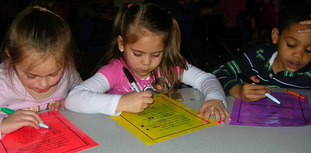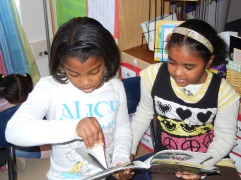Reading Fluency Words Per Minute Grade Level Chart
Reading Fluency Strategies
- Bound to our Reading Fluency Activities Page
The post-obit strategies and activities are designed to reach two chief goals:
1. To help children read words accurately and effortlessly.
2. To aid children read with appropriate rates of reading fluency. Katie and I frequently discuss the keys that let united states of america to assist many new or struggling readers achieve the above goals. From our experience, we both hold the cosmos of fluent readers is dependent on two instructional ingredients (it is likewise overnice to know our conclusions are backed by inquiry besides).
Readers become fluent from:
- Explicit instruction, feedback & guidance AND
- Practicing with appropriate textsFor detailed knowledge on reading fluency itself we recommend the post-obit information: Click here to download Fluency Tasks, Texts, and Instruction
Reading Fluency Strategies
Repeated Reading
Repeated reading ways that students read the same reading passages or texts repeatedly until a desired level of reading fluency is achieved. Katie and I both incorporate this specific reading fluency strategy near daily into our reading instruction.
A version of the method of repeated reading nosotros often use is equally follows:
- An adult chooses a passage to read that is slightly in a higher place the kid's instructional level only still one that will promote educatee success. Out of grade-level materials may be used for a child reading significantly below grade level. A reading passage or extract with approximately 100 words is desirable although different lengths can be used depending on the reader.
- The child reads the passage aloud, while the adult times him or her using a stopwatch for a specific amount of fourth dimension (usually i minute). Some cull to make an audiotape recording of the child'due south reading. As the kid reads, the developed marks all of the words read incorrectly. If a child gets stuck on a word the adult gives them the give-and-take after 5 seconds.
- When the time is upward the student or adult marks where they stopped. The developed reviews the miscues with the child, using the audiotape or discussion and counts the number of words the child read correctly. This number is the goal to beat on the next reading! Our students dear to graph the number of words they read correctly each time. Plus, it helps build math skills!
- The child rereads the same passage for the same corporeality of time and the adult marks the child'south miscues again. Remember, the child is trying to read past their previous catastrophe marker.
- The child and adult continue Steps 3 and 4 until the child achieves a predetermined goal. This goal could be a predetermined number of words read correctly or a predetermined number of times the child has to beat their previous score. If the child does non significantly improve the number of words read correctly each endeavour, the adult might desire to discontinue and utilize an easier passage.
- When the child can read a passage relatively fluently on the first reading, the adult provides a more than difficult passage. Information technology is important to progressively challenge the kid and then that reading improvement can be fabricated.
Click hither to download a First Grade Words Correct Per Minute Graph
Click here to download a Second Form Words Correct Per Minute Graph
Click here to download a Tertiary Grade Words Right Per Infinitesimal Graph
We've created a parent-friendly homework log to help your students practice reading fluency with repeated reading at habitation! Check it out, here:
Repeated Reading Homework Log
Repeated Reading (Grouping Version)

This version of repeated reading can be washed individually or with both modest groups and whole classes. Hither is how to employ this reading fluency strategy with more than than ane child:
Children brainstorm reading orally from multiple copies of the same text on cue. After 1 to three minutes, the teacher calls "time" and children mark where they stopped with a pencil. After the reading, the instructor or the children can bring upwards words that gave the children difficulty. The teacher then repeats the procedure 2 more times, with the children marking how far they got each time.
Here is another version of the repeated reading method commonly used:
- An adult chooses a passage that is slightly above the kid'south instructional level.
- The child reads the ENTIRE passage aloud (a using an excerpt effectually 100 words is desirable), while the adult times him or her using a stopwatch. The adult tin cull to brand an audiotape recording of the child'south reading. As the child reads, the adult marks any give-and-take that is not read correctly. The adult records the corporeality of time it took to read the passage.
- The teacher reviews the miscues with the child, using the audiotape or discussion.
- The child rereads the passage, and tries to vanquish their previous time while making less reading errors.
- The child and developed continue Steps 3 and 4 until the child achieves a predetermined number of words read correctly per minute (number of words read correctly divided by time). If it takes more than than seven tries to reach the goal, the adult might want to discontinue and use an easier passage. Repeated reading of a passage unremarkably takes more than than one teaching session. The adult charts each attempt.
- The adult selects another passage at the same level. When the child can read a passage relatively fluently on the showtime reading, the teacher provides a more difficult passage. It is important to progressively challenge the child so that reading improvement tin can be made. Several variations to this strategy can be fabricated to keep the task fun for kids. Just remember to provide cosmetic feedback and guidance and to cull appropriate texts.
Paired Reading
In paired reading a capable reader and a struggling reader read in unison. The struggling reader indicates when they are fix to try reading lonely. If the pupil makes an mistake, the capable reader provides the correct word. The pair then reads the sentence with that word in unison and continues reading. Dissimilar from repeated reading, Topping and Whitley (1987, 1990) constitute that paired reading tin can significantly better reading fluency.
Ways Parents Tin Amend Reading Fluency with Paired Reading
Rasinski (1995) describes how paired reading is used at home. Each night the parent reads a brief poem or passage to their child. This is followed by the parent and child reading the passage together several times. Then the child reads the text to the parent.
A cracking book for this type of paired reading isY'all Read to Me, I'll Read to You: Very Short Stories to Read Together past Mary Ann Hoberman.
In his written report, Rasinski found that children who engage in this form of paired reading demonstrated pregnant gains over children who received tutoring without this paired reading back up. Parents, if you are paying for tutoring become more than bang for your buck past using this practice at dwelling with your child. Teachers and tutors, share this information with your parents to support your instruction efforts and help increase your students' reading fluency!
Choral Reading

Choral reading (where groups of children read the same text aloud in unison) is one of our favorite reading fluency strategies. Because of its effectiveness, teachers should find means to incorporate choral reading into their daily classroom pedagogy. Choral reading is nifty because information technology maximizes the amount of reading done per each kid. Compared to round robin reading the utilise of choral reading certainly results in more reading than 1 kid reading ane line or paragraph of text, i at a fourth dimension. Katie and I rely heavily on repeated reading AND choral reading during our fluency instruction. Struggling readers truly benefit from combining both approaches! We will choral read a poem or story several times and each time we read their confidence grows.
Echo Reading
Echo reading is another favorite of ours because it allows children to practice proper phrasing and expression while building oral reading fluency. In echo reading, the teacher or parent reads one sentence or paragraph (length can vary) at a fourth dimension while the pupil follows along in the text with their finger. Once the developed pauses, the student echoes back the same sentence or paragraph following forth with their finger so that you can exist sure the student is really reading and not simply copying y'all. The guided practice and back up of the echo reading structure instills confidence in students aiming to develop greater reading proficiencies.
Parents, take a reluctant reader at habitation?Use this method equally a way to get hesitant readers to practice with you at home. Nosotros accept constitute that stubborn readers take a tendency to let their guard down when you exercise with them using the echo reading method.
Teachers, share this method with your parents as a way to encourage structured reading practice at domicile!
Source: https://www.readingresource.net/readingfluency.html
0 Response to "Reading Fluency Words Per Minute Grade Level Chart"
Post a Comment